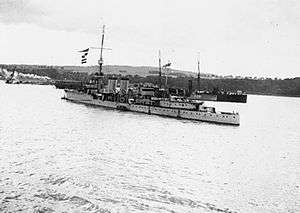HMS Champion (1915)
 HMS Champion during World War I. | |
| History | |
|---|---|
| Name: | HMS Champion |
| Builder: | Hawthorn Leslie and Company |
| Laid down: | 9 March 1914 |
| Launched: | 29 May 1915 |
| Completed: | December 1915 |
| Commissioned: | 20 December 1915 |
| Decommissioned: | October 1924 |
| Recommissioned: | May 1925 |
| Decommissioned: | December 1933 |
| Fate: | Sold 28 July 1934 for scrapping |
| General characteristics | |
| Class and type: | C-class light cruiser |
| Tons burthen: | 3,750 tons |
| Length: | 446 ft (136 m) |
| Beam: | 41.5 ft (12.6 m) |
| Draught: | 14.5 ft (4.4 m) |
| Propulsion: |
|
| Speed: | 28.5 knots (53 km/h) |
| Range: | carried 405 tons (772 tons maximum) of fuel oil |
| Complement: | 324 |
| Armament: |
|
| Armour: |
|
HMS Champion was a C-class light cruiser of the Royal Navy that saw service during World War I. She was part of the Calliope group of the C class.
Construction
Eight light cruisers were ordered for the Royal Navy in the 1913 budget. The six ships of the Caroline class used conventional direct-drive turbine engines but two, Champion and Calliope, had experimental engine designs using geared reduction to match optimum working speeds of turbines and propellers. This followed experimental designs ordered in 1911 using geared high-pressure turbines for the destroyers Badger and Beaver and in 1912 using gearing for both high-pressure and low-pressure turbines in the destroyers Leonidas and Lucifer. Champion and Calliope tested different designs.[1]
Built by Hawthorn Leslie and Company at Tyneside, England, Champion was laid down on 9 March 1914, launched on 29 May 1915, and completed in December 1915.[2]
Champion had two propeller shafts, the port one being driven from the sternmost engine room and the starboard one from forward. Gearing increased overall engine efficiency, allowing a reduction in boiler and turbine size for a given force provided by the propellers, so the initial design reduced the boiler room size and dropped the nominal developed power from 40,000 shaft horsepower (shp) (29.8 megawatts/MW) to 37,500 shp (28.0 MW). However, during construction modifications were made to again increase boiler capacity and add cruising turbines which returned to the nominal power output of the Caroline class ungeared ships. Maximum propeller speed was a nominal 340 revolutions per minute. Trials comparing Champion to Caroline showed that at actual developed power of 41,000 shp (30.6 MW) in both ships, Champion achieved a speed of 29.5 knots using 470 tons of fuel per day, while Caroline achieved 29 knots using 550 tons of fuel per day. The ship could achieve 28 knots operating at the lower power of 31,000 shp (23.1 MW).[1]
Service history
World War I

Champion was commissioned into service in the Royal Navy on 20 December 1915. She was assigned to the Grand Fleet upon completion, serving as the leader of the 13th Destroyer Flotilla through the end of World War I and until early 1919. She fought in the Battle of Jutland on 31 May-1 June 1916, during which she also was the flagship of Commodore (D), the senior commander of the fleet's destroyers.[3]
Postwar
Champion briefly served in the 2nd Light Cruiser Squadron during 1919. She then was attached to the Royal Navy Torpedo School, HMS Vernon, from 1919 to 1924, undergoing a refit in 1923. She was decommissioned and placed under dockyard control at Portsmouth in October 1924.[3]
In May 1925, Champion was recommissioned to serve as Gunnery Firing Ship. She was attached to the Signal School in 1928,[3] and was used as a testbed for the Royal Navy's first remote-power-control (RPC) gunnery systems that year.[4] She was decommissioned in December 1933 and placed under dockyard control.[3]
Disposal
Champion was sold on 28 July 1934 to Metal Industries of Rosyth, Scotland, for scrapping.
Notes
- 1 2 Brown p.24-25
- ↑ Gardiner, Robert, ed., Conway's All the World's Fighting Ships, 1906-1921, Annapolis, Maryland: Naval Institute Press, 1985, ISBN 0-87021-907-3, OCLC 423834653, LCCN 84-42782, p. 57, (preview of 2006 reprint).
- 1 2 3 4 Gardiner, Robert, ed., Conway's All the World's Fighting Ships, 1906-1921, Annapolis, Maryland: Naval Institute Press, 1985, ISBN 0-87021-907-3, OCLC 423834653, LCCN 84-42782, p. 58, (preview of 2006 reprint).
- ↑ Rippon, Peter, 1988. Evolution of Engineering in the Royal Navy: 1927 - 1939, Volume one, p. 258
References
- Colledge, J. J.; Warlow, Ben (2006) [1969]. Ships of the Royal Navy: The Complete Record of all Fighting Ships of the Royal Navy (Rev. ed.). London: Chatham Publishing. ISBN 978-1-86176-281-8. OCLC 67375475.
- Jane's Fighting Ships of World War One (1919), Jane's Publishing Company
- Ships of the Calliope class
- Brown, David (1997). The Grand Fleet. Barnsley: Seaforth publishing. ISBN 978-1-84832-085-7.